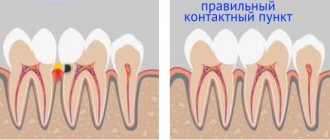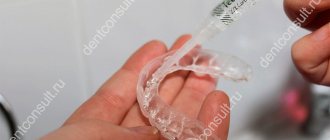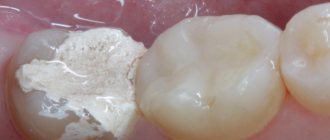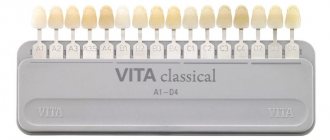Many patients do not know that they can put fillings on their front teeth. Its goal is not only to eliminate defects, but also to restore anatomical, physiological and aesthetic properties.
The procedure is quite popular. In order for the result to please the patient, it is necessary to choose a competent specialist with extensive experience. A professional will select the necessary material individually for each type of teeth and install the product so that it will not be noticeable in the smile area.
Installing a temporary filling
A filling between the front teeth is often placed due to carious lesions. For several days, it protects healthy tissues and nerve endings from external influences.
After a session of cleaning the canals and removing the nerve, the structure is replaced with a permanent one.
Life time
temporary product depends on the need for installation. As a rule, it is worn for no more than one month. Lasts about three days if arsenic is present.
When treating pulpitis or advanced stages of caries, the reaction of the unit is checked. Antibiotics are applied under the material. In this case, you need to walk for at least three weeks. The installation method is identical.
The following can be used as the main material:
- polycarboxylate cement,
- dentine,
- vinoxol,
- karyosan,
- softened paste
How long can a filling last?
The service life of a filling is determined by several factors, the main ones being the following:
- correct installation and size,
- characteristics of the material from which it is made,
- the condition of the abutment tooth, the thickness of its walls,
- features of hygienic care: brush hardness, abrasiveness of pastes, etc.
- the presence or absence of certain habits: for example, high consumption of nuts, seeds, opening corks with teeth,
- the predominance of solid and/or tough foods in the diet, and so on.
As a rule, the minimum service life is 3-5 years, but some materials can last 10 years or more. In fact, it depends more on the condition of the treated tooth itself after a while.
Replacing a filling
Sometimes it becomes necessary to change fillings on the front teeth. Replacement is due if it is fixed:
- Violation of the integrity of the closure of the carious cavity. This process provokes infection.
- Vertical or horizontal shrinkage of material.
- Heavy load due to chewing. Because of this, destruction occurs.
- The development of periodontal tissue diseases - gingivitis, periodontitis.
- Overhang of the edges on the gum.
- Wear due to flat occlusal surface.
- Change in the shade of an artificial tooth (usually darkening).
- Poor quality of oral hygiene.
- Diastema of the frontal units.
- Changing the inclination.
- Insufficient cleaning of dental plaque in the area adjacent to adjacent molars.
Treatment methods – from filling to implant
The dentist will select the treatment method for the front teeth after an examination.
- Veneers or Lumineers
If the incisors are severely damaged, thin overlays can be placed - veneers or lumineers. They will hide the consequences of caries and make teeth whiter and smoother.
- Dental crowns
If only the root remains of the front tooth, intra-root inlays are made; this is the basis for the crown. Metal crowns are not suitable for front teeth; they will be too noticeable. To make an artificial tooth as similar as possible to a real one, it is better to use ceramic and zirconium crowns.
- Bridges and implants
If desired, missing front teeth can be replaced by bridges and clasp dentures. If funds allow, you can install an implant and forget about the problem for many years.
Painfulness of the procedure
Most people are afraid of the procedure precisely because of toothache, but modern technology and the use of anesthesia eliminate this ailment.
The session is completely painless. To reduce the likelihood of discomfort, all manipulations are carried out after the administration of an anesthetic. If there is no nerve, the procedure is performed without anesthesia. The patient may feel slight pressure on the gum.
An exception is intolerance to certain medications used for anesthesia. The choice is made in favor of a similar drug with a different active substance.
After the injection, no painful sensations are observed.
It hurts if there is a strong inflammatory process at the root apex and in the canals. Unpleasant sensations occur only when the drug gets into the periodontal tissues. They go away instantly after increasing the dosage of the painkiller.
Some pain is possible if there is a deep stage of carious lesions, depulpation or canal treatment is performed, or sensitivity is increased.
Is a refilling necessary if nothing bothers me?
Many patients are surprised when a dentist recommends replacing an old filling with a new one, because they have no pain or other unpleasant symptoms. However, replacement is carried out not only in cases of severe inflammation, but also for preventive purposes, as well as to improve the aesthetics of the dentition.
Like any other material, the filling mass is subject to gradual wear, deformation, and destruction. Hygienic care, oral microorganisms, saliva pH, mechanical, chemical and temperature effects of food over time provoke the appearance of microscopic cracks in the filling. The resulting pores serve as a breeding ground for microbes and the development of dental diseases.
Installation on the front teeth
The procedure takes from half an hour to an hour and a half, depending on the complexity of the problem.
The stages of setting up the frontal units are as follows:
- Carrying out professional oral hygiene. The hygienist cleans the molars and interdental space from plaque.
- Determination of tone.
- Introduction of anesthesia. The anesthetic is selected taking into account the patient's tolerance to the active substance. The injection is given in the gum area.
- Removal of caries. If the pathology affects only the superficial layers, then the disease is eliminated by grinding.
- Removal of the inflamed area of the pulp.
- Preparing the plane. The dentist treats the surface with a drill.
- Acid and adhesive treatment of dentin and enamel for better adhesion.
- Treatment with an antiseptic solution. This point is important in order to reduce the risk of microbial development.
- Application of material. It hardens quickly, so it is important to “shrink” it immediately with a special tool.
- Bite check. To do this, the doctor asks the patient to bite down on a plate of dye. When a certain area of this element is painted, a violation is considered.
Performing grinding and polishing of the artificial surface for proper bite and ideal smoothness.
When restoring the anterior dentition, diastema closure is often performed. This is possible if the spaces between the central molars are small. More material is applied to the incisors to increase their width. Thus, the distance between them disappears.
Why does caries develop under the filling mass?
The development of a carious process under the filling material is often observed due to poor-quality treatment of the tooth cavity during treatment. The remains of the affected tissues serve as a source of infection, which intensifies and covers increasingly larger areas of the dentition unit.
Caries can also form if the filling is carried out in violation of the protocol. An incorrectly applied composition quickly becomes unusable, losing its fixation with the walls of the tooth cavity or collapsing under the influence of the aggressive environment of the oral cavity. Microbes penetrate into the resulting cracks and voids, which “trigger” the destructive process.
Another factor that provokes the development of caries is the natural “aging” of the filling. The appearance of microdamages (and micropores) on it and in it, which is inevitable over time, contributes to the accumulation of pathogenic bacteria, their reproduction, and the occurrence of recurrent disease. Therefore, it is advisable to replace old fillings with new ones after their expiration date.
Types of fillings for front teeth
The design on the frontal incisors must have such properties as resistance to abrasion and destruction, biocompatibility, thermal conductivity to protect against exposure to different temperatures, and matching the enamel in structure and shade.
There are several types of materials. They have their own characteristics:
- Cement silicophosphate
(zinc phosphate or polycarboxylate) material. Among the advantages, it is worth highlighting the low cost. However, there are many more disadvantages: Firstly, fixation and adherence to the walls is insufficient. Secondly, the color is noticeably different, since the cement quickly acquires a yellowish tint. Thirdly, the surface of the artificially created unit is poorly polished. - Composite
The structure, shape and color of a natural incisor are most clearly conveyed. It is characterized by increased strength. The downside is the risk of roughness if the material is not mixed well. - Plastic.
Its advantages include a tight fit, aesthetic component and mechanical strength of the material. The color palette is wide and you can easily choose a shade to match the color of your teeth. The negative aspects are that the plastic darkens and turns yellow, the surface gradually becomes rough, acrylic releases toxins and also shrinks.
When choosing, you need to know how long different types of fillings last. Cement is short-lived. Their service life does not exceed one and a half years. Plastic products last up to three years. Good composite fillings last up to five years.
Requirements for filling materials
The main requirements that filling materials must meet, regardless of service life and purpose of use, are:
- Biological safety;
- Hypoallergenic;
- Easy to install and remove;
- Strength;
- Loyalty to medicines;
- Good resistance to mechanical loads and aggressive environments.
Modern dentistry has a large selection of filling materials.
In this regard, dentists quite often ask their patients questions regarding the choice of filling material, offering various types of dental fillings. To make it easier to make a decision, it is necessary to take a closer look at all types of fillings used in dentistry.
The best choice of fillings for front teeth
The filling must close the cavity and prevent infection of the canals. In the case of front teeth, the aesthetic aspect comes to the fore, so the material must have the appropriate properties.
The most durable fillings for damaged front teeth are light products
. They are made from a material that hardens under ultraviolet rays. The composition contains heliocomposite, glass-ceramic filler, and resin.
Durability of photopolymers
Photopolymers are characterized by increased strength. They can last up to 10 years. They are resistant to temperature, restore length and shape.
Reflective filling has many advantages
:
- Eating food and water is allowed immediately.
- Increased adhesive ability.
- Plastic. The material allows you to clean out any pores and cracks.
- Layer-by-layer application. Due to this, the grip is enhanced.
- The percentage of shrinkage is minimal compared to chemical analogues.
- Does not release toxins.
- Possibility of fixing in a small area.
- Possibility of choosing a color that is similar to enamel.
Minus
is high cost. As a result of the use of a UV lamp, the price does not allow the use of a light filling as a temporary structure.
Contraindications for filling
There are very few contraindications to filling. Usually they are limited to recommendations for the use of a specific type of filling, since they may be allergic to others.
Other contraindications include the following:
- subgingival destruction, which limits access to the damaged area and also makes it impossible to isolate this area from saliva;
- the presence of bruxism in the patient, which is accompanied by frequent grinding of teeth for no reason, as a result of which fresh fillings are quickly destroyed;
- increased tooth abrasion, which will also quickly render the filling unusable.
In addition, filling is not carried out when more than 1/3 of the tooth is damaged by caries. In this case, the doctor may recommend its removal with further use of the implant. Another solution may be to use a crown, which is placed on a completely cleaned tooth.
Yellowing of fillings on front teeth
Patients often experience discoloration of artificial units.
Causes
Common causes of pathology are:
- Getting injured.
- Secondary caries.
- Drinking black tea or coffee.
- Smoking.
Darkening is possible when the nerve is removed.
Correction methods
The first step is to carry out the whitening procedure. You can get rid of yellowing only with photopolymers. Only if the structure has lightened slightly does it need to be replaced.
Whitening methods
Photopolymers are bleached using the in-channel method. A special gel is injected into the root canal and a temporary structure is placed. After 2-3 procedures, the shade becomes lighter, and the structure is replaced with a permanent one.
What determines the price of a chemical composite filling?
The cost of installation is calculated by the dentist after examination and diagnosis. It depends on:
- the degree of tooth decay and the need to use additional means (for example, linings for caries);
- area of location of the affected dental unit;
- pricing policy of the dental clinic and the level of qualification of the dentist.
You can make an appointment with CELT dentists online or by contacting our information line operators.
Make an appointment through the application or by calling +7 +7 We work every day:
- Monday—Friday: 8.00—20.00
- Saturday: 8.00–18.00
- Sunday is a day off
The nearest metro and MCC stations to the clinic:
- Highway of Enthusiasts or Perovo
- Partisan
- Enthusiast Highway
Driving directions
Lost filling on a front tooth
Causes
The reason for material loss may be:
- Neglect of oral hygiene and, as a result, plaque formation.
- Untimely removal of tartar.
- Inflammation of the pulp.
- Mechanical injuries.
- Chewing food with frontal incisors.
- Poor tooth preparation before the procedure.
- Eating seeds, nuts, etc.
- Excessive load on the front units. For example, opening lids, chewing threads, etc.
Elimination methods
With high-quality elimination of carious cavities, correction is carried out within a month. If the product was placed in the treatment of deep caries, then you should immediately contact the dentist to exclude an infectious process.
Treatment is prescribed depending on the cause of the loss. If there is repeated caries or loss of a pulpless tooth, re-installation does not make sense. The doctor suggests installing a pin or crown.
What to do if a piece of the filling breaks off
In this case, you should immediately visit a dentist
. The doctor will correct the problem in one visit if no spread of secondary caries is noticed.
If the chip occurs from the edge, then the restoration is carried out with the same material that was originally used. If a significant part has broken off, the doctor suggests changing the material or performing a complete restoration and extension.
Dental filling methods
All methods of filling teeth are based on the use of various materials, which have their own advantages and disadvantages. Therefore, when choosing a technology, the doctor focuses on the individual characteristics of the structure of the root canals and the patient’s body as a whole.
Filling teeth with gutta-percha
Removal of the nerve of the tooth and filling of the canals, when the cavity is filled with a special paste based on gutta-percha with the addition of various impurities. Despite its simplicity and relatively low cost, this method of filling teeth cannot be called reliable and safe. It is often accompanied by a violation of tightness, the development of inflammation and allergic reactions.
Using a pin
Filling a pulpless tooth with pins is one of the most common techniques in dentistry. There are two types of pins (fillers): gutta-percha and metal. Filling tooth canals with gutta-percha is considered a more reliable and safe method. Even taking into account the presence of polymers, dyes and metal salts, such pins are biocompatible and do not cause allergies. Silver metal structures have good flexibility and can be installed in long and curved channels, however, silver is prone to oxidation, which can lead to inflammation. Titanium posts are better in terms of tissue compatibility, but they are very rigid and require the preparation of a special bed, which makes the tooth walls extremely fragile.
Sealers-sealers
Even gutta-percha pins for filling the root canals of teeth by themselves are not able to provide a reliable result, since they do not have antibacterial properties. To improve the quality of filling, dentists use sealers - sealants that ensure a tight fit of the material to the canal walls. There are natural (based on cement, zinc oxide, etc.), polymer sealers, glass ionomer cements and pastes based on calcium hydroxide.
The filling on the front teeth interferes after treatment
In some cases, the design on the frontal incisors prevents the mouth from closing completely; the roughness injures the tongue or the mucous membrane of the lips.
Causes
Trouble arises if sufficient grinding and grinding of the excess surface has not been carried out.
Much less commonly, the cause is an excess of applied material when correcting the interdental gap on the front teeth.
The rarest situation occurs when the wall between the filling and the pulp chamber is thinned. There is a feeling of discomfort that irritates the nerve.
Complications
Ignoring pathology can lead to unpleasant consequences. For example:
- The high position of the artificial structure causes a lot of pressure on the jaw. Pulpitis and periodontitis gradually develop.
- Increases the likelihood of chipping.
- Uneven closing of the jaw contributes to its dislocation and other diseases of the temporomandibular apparatus.
What are the installation steps?
Patients often note that the tooth under the filling hurts. Also, from visitors to modern clinics you can hear the question: “A filling has fallen out of a tooth, what should I do?”
As a rule, such situations occur due to the fault of an incompetent doctor who does not know all the intricacies of treatment or does not follow the technology for installing a filling. Next, we will talk about the algorithm for filling teeth, which must be strictly adhered to:
- Initially, an examination of the oral cavity is performed, lesions are identified and a diagnosis is established;
- Next, the doctor anesthetizes the affected dental unit, which minimizes discomfort during subsequent treatment of the affected surface;
- After this, the carious cavity is cleaned and medicated in order to prepare it for the filling procedure;
- In the presence of massive lesions, a special therapeutic pad is used, which helps to quickly eliminate the inflammatory process;
- For the aesthetic part of the filling base, an insulating gasket is used that has the ability to adhere;
- Subsequently, filling material is applied to the prepared surface;
- If a photopolymer mass is used during the filling process, then each layer is exposed to a polymerization lamp.











